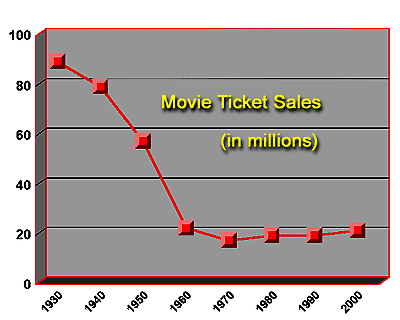Film, Radio and TV - 5 |
The End of the
Two years later--these legal things take a while--after denying any monopolistic practices, the studios agreed to stop buying theaters, eliminate blind booking (requiring theaters to rent films without seeing them first), and limit block booking to five films. But, that didn't fix things, and four years later the major studios still held major control over the motion picture industry--especially when it came to first-run exhibition of films in major cities. Antitrust action was again launched, and this time the five major studios--MGM-Loew's, RKO, Warner Brothers, Paramount, and 20th Century Fox--responded by divesting themselves of all theaters. But, that resulted in another problem. Without the previous level of control and profit guarantees, the big banks were now So the studios finally decided to leave the production of films (and much of the financial risk) primarily to outside independent producers--independent of the big five studios, not "independent," as the term is used today. We'll go into that in the next module. The antitrust action spelled the end of the studio system and the beginning of an era in which production companies primarily made films on a project-by-project basis. This new breed of production company is often assembled for a particular film and then dissolved afterwards. There are no stars or directors under long-term contracts to be automatically used for ongoing productions. Today, people are especially selected for each film. Although the studio system was efficient at turning out films--some very good ones, in fact--many feel that the present system encourages a level of competition essential to maintaining Hollywood's leadership in filmmaking. Today, the major studios--Columbia, Paramount, 20th Century-Fox, MCA/Universal, Time Warner and Walt Disney--typically make fewer than 20 films a year. At the same time, they distribute most of the rest of the major films. |
By the 1950s, television had taken hold in the United States. The impact of television during the 40s and 50s is dramatically shown in the graph below.
Facing a financial crisis once again, the studios fought back by trying:
But, even though the U.S. population continued to grow, you can see from the graph above that movie attendance dropped dramatically, until it bottomed out in the 60s and 70s. In a burst of shortsightedness, many film studios put clauses into actors' contracts forbidding them to appear on TV--even to promote their own films. However, the studios soon found that instead of being an enemy, television represented an important new market for their films--one that would soon be essential to their survival. Once they realized this, they made some major adjustments. For example, they abandoned their expensive star system, their huge promotional budgets, and most of the films aimed at general audiences. Instead, they started making films aimed at distinct audiences: more highly educated and affluent people, and especially people under 30. The latter soon became their largest audience, accounting for 75% of ticket sales. These new audiences, although much smaller, Simplistic, low-budget, formula plots, common in Hollywood's earlier eras, just didn't make it with younger, more sophisticated audiences. Films that center on social justice, sexual freedom, and new levels violence are now common--themes that are less attractive to older audiences. With the arrival of (general audience) TV, Hollywood also found a new, seemingly insatiable market for their old films. During the early days of TV, they dug out old black and white films and sold them to TV. When color TV arrived, the studios again went into their film vaults and offered supplies of color films.
Note in this graph that only about 25% of profits now come from ticket sales. Before we complete our look at film history, we need to note that something else has changed. Today, the major studios are owned by large conglomerates that focus almost entirely on quick profits. The success or failure of films tends to be judged by profits from the first week or so of screenings. The majority of U.S. film studios are now foreign owned--a larger percentage than in any of the other mass media. Creative mentalities and stars are desirable when they translate into profit for the parent insurance, media, oil, bank, and investment concerns that now control the studios. This is also one of the reasons that profit-making themes
as gratuitous violence and ever-more-bloody horror films continue to
be produced on a wide scale--even in the face of educated public disapproval
and studies that show that the effects of viewing violence are harmful
to both individuals and society. This is Sexual content is also related to box office success, and
although it is widely assumed that On the average, only one in every six films produced results in a real profit. However, the major hits take in much more then their production cost, and end up paying for films that are less successful. The average cost of producing a film today is about $40-million. Most movies are financed only after ancillary rights (income from non-box office sources, such as TV, video rental, and foreign distribution) are projected. American movies, TV programs, and software constitute the largest avenue of export for the United States. One-third of film profits come from foreign distribution. As we will see in the next module, there is a new breed of independent film producers that seek to escape the limitations of corporate control, and explore controversial ideas that are not (yet) accepted by popular audiences. But even with the limitations imposed by the large film studios, films continue to shape public attitudes in a wide variety of areas-- sometimes in rather positive ways. You can't discount the positive moral values that Disney films have communicated to young people for decades, or the disturbingly thought-provoking films of Steven Spielberg (Schinder's List, Saving Private Ryan, etc.), or films that take moral stands against seemingly invincible corporations (A Civil Action,The Insider, Erin Brockovich, etc.). Commercial excesses aside, in the United States, Canada, and many countries the free selection of films at the box office represents a type of democratic vote that, for all its weaknesses, goes a long way toward insuring that films continue to represent a large segment of the public's hopes, fears, and private dreams. For those who are interested in this part of film history here's a list of the |

 reluctant to finance films.
reluctant to finance films. 
 Television had become the country's new primary source of family entertainment.
Television had become the country's new primary source of family entertainment. demanded more in the way of meaningful content and sophisticated production techniques.
demanded more in the way of meaningful content and sophisticated production techniques.  Today, most Hollywood films don't begin to make a profit until they move to TV, videocassettes, DVD, pay-TV, and foreign distribution.
Today, most Hollywood films don't begin to make a profit until they move to TV, videocassettes, DVD, pay-TV, and foreign distribution.